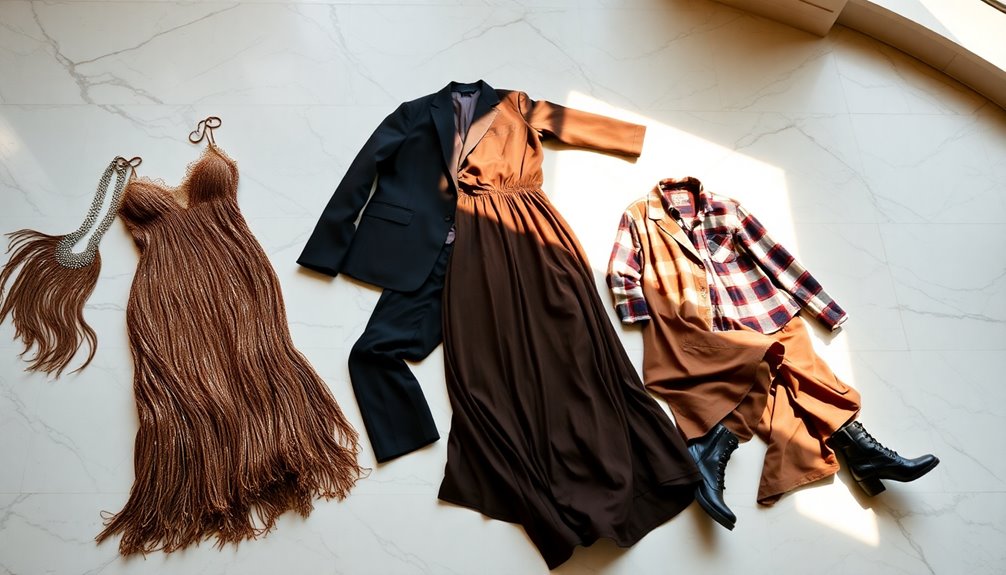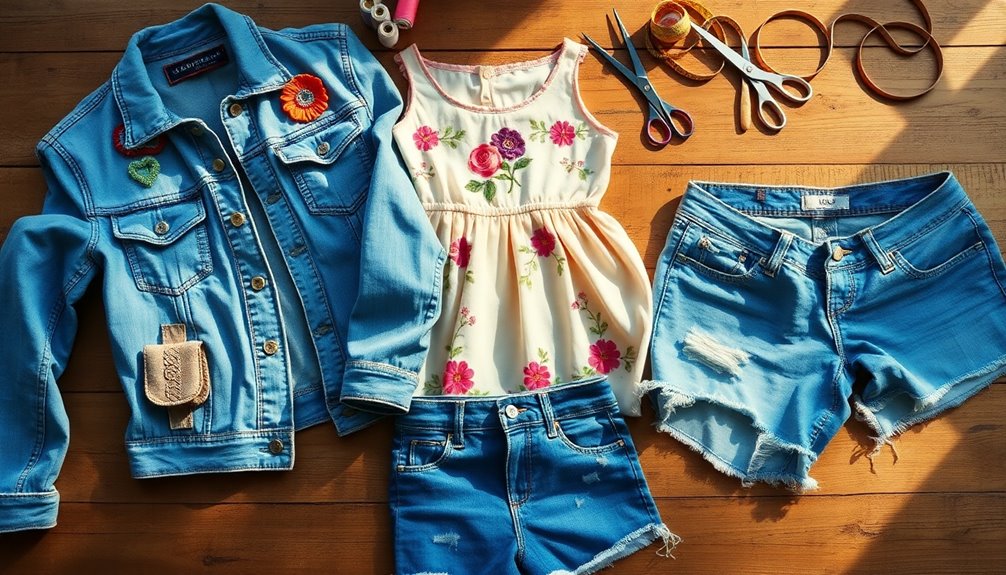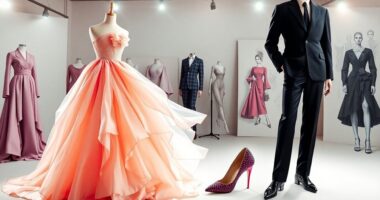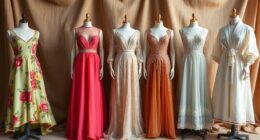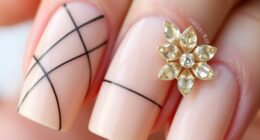Fashion trends have always shaped our culture, and five styles stand out. In the 1900s, the S-Bend corset defined women's silhouettes with its exaggerated curves. The 1920s embraced the flapper style, symbolizing liberation through loose dresses and cloche hats. Fast forward to the 1940s, the New Look by Christian Dior revived elegance with cinched waists and lavish fabrics. The 1960s brought the miniskirt, championing freedom and individuality. Finally, the 2010s introduced athleisure, blending fitness wear with everyday style. Each trend reflects cultural shifts, and there's so much more to explore about their impact!
Key Takeaways
- The S-Bend corset of the 1900s created an exaggerated hourglass figure, defining women's fashion but later criticized for health issues.
- Flapper style in the 1920s embraced liberation with drop-waist dresses and knee-length hemlines, symbolizing women's self-expression during the Jazz Age.
- The 1940s New Look by Christian Dior revitalized luxury fashion with cinched waists and voluminous skirts, marking a return to elegance post-war.
- The miniskirt revolution of the 1960s challenged traditional norms, promoting freedom and individuality in women's fashion with bold designs.
- The 2010s athleisure trend merged athletic wear with casual fashion, driven by fitness culture and social media's influence on body positivity.
The S-Bend Corset of the 1900s
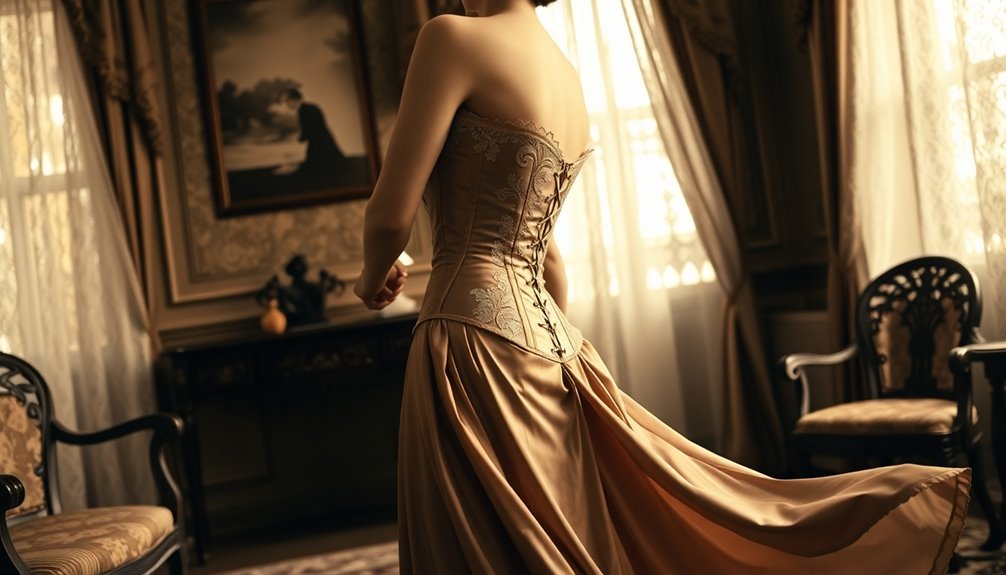
The S-bend corset of the early 1900s represents a defining moment in women's fashion, emphasizing an exaggerated hourglass figure.
Also known as the Edwardian corset, it was designed to push the bust forward and the hips back, creating that coveted S-shaped curve. Popularized during this time, it became a staple of women's fashion, influencing the aesthetics of the Edwardian period.
However, the S-bend corset faced criticism due to its health implications, as it restricted movement and often led to physical ailments.
As the 1910s approached, changing social norms encouraged the rise of more comfortable silhouettes, signaling the decline of the S-bend corset's popularity and paving the way for a new era in women's clothing.
Flapper Style of the 1920s
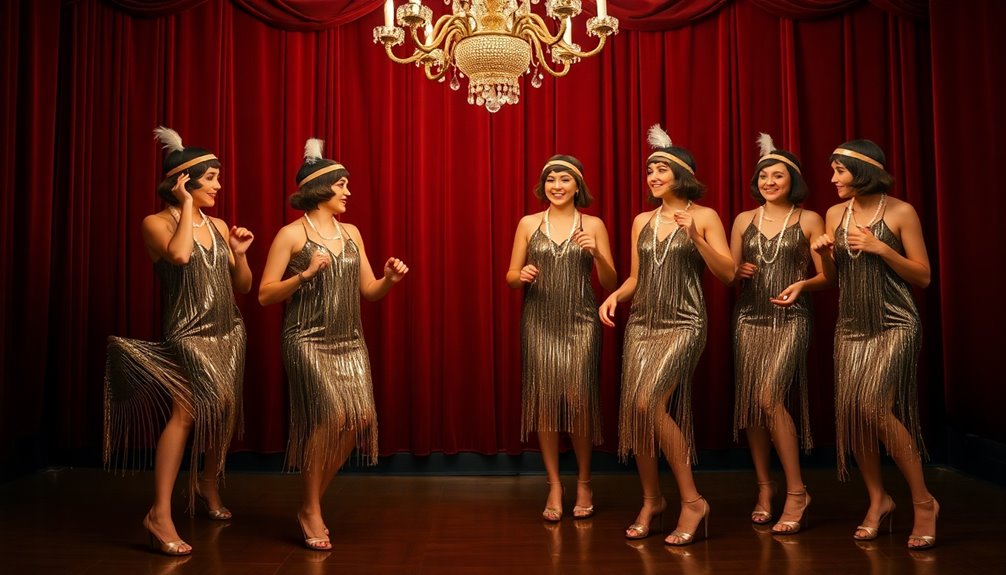
Emerging from the backdrop of post-World War I, flapper style revolutionized women's fashion in the 1920s, embodying a spirit of liberation and modernity.
You'll notice the loose, drop-waist dresses with knee-length hemlines, which marked a significant departure from previous restrictive clothing. This playful spirit reflected a cultural shift towards women's liberation, as women embraced comfortable styles that allowed for movement.
The little black dress, popularized by Coco Chanel, became a staple of modern femininity and simplicity. Accessories like cloche hats, long strands of pearls, and feathered headbands completed the flapper look.
This fashion not only transformed wardrobes but also influenced social norms during the vibrant Jazz Age, celebrating a newfound sense of freedom and self-expression.
The New Look of the 1940s
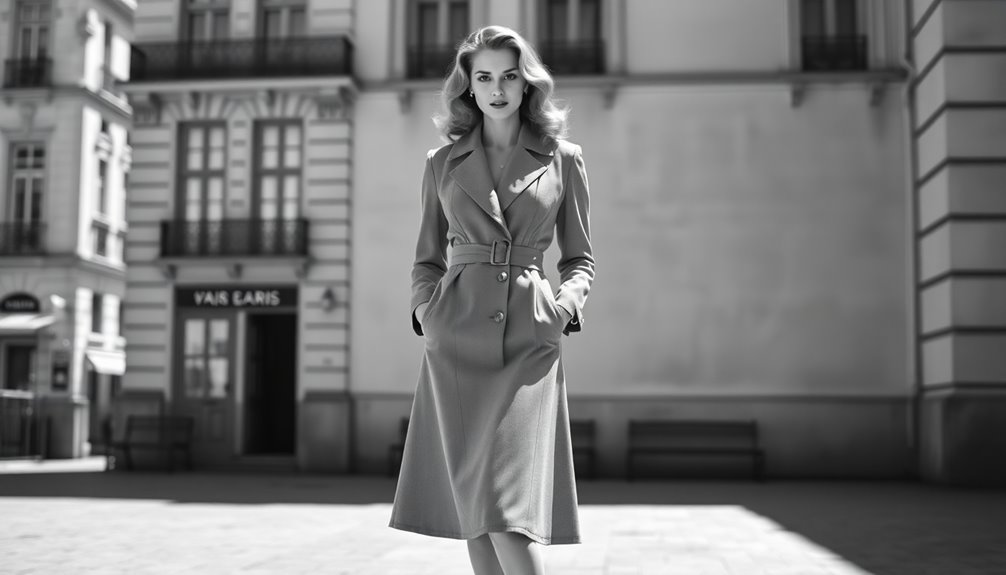
After the bold experimentation of the flapper era, the fashion world took a dramatic turn with the introduction of the New Look in the late 1940s.
Christian Dior revolutionized women's fashion by emphasizing an hourglass silhouette that celebrated femininity. This iconic style marked a significant cultural shift in the post-war era, moving away from wartime utilitarianism to luxurious fabrics like taffeta and silk.
Key features of the New Look include:
- Cinched waists that accentuated curves
- Voluminous skirts that fell to mid-calf
- An embrace of extravagance and joy
- A global influence reshaping fashion identities
The New Look symbolized a return to elegance, forever transforming women's dressing styles.
The Miniskirt Revolution of the 1960s
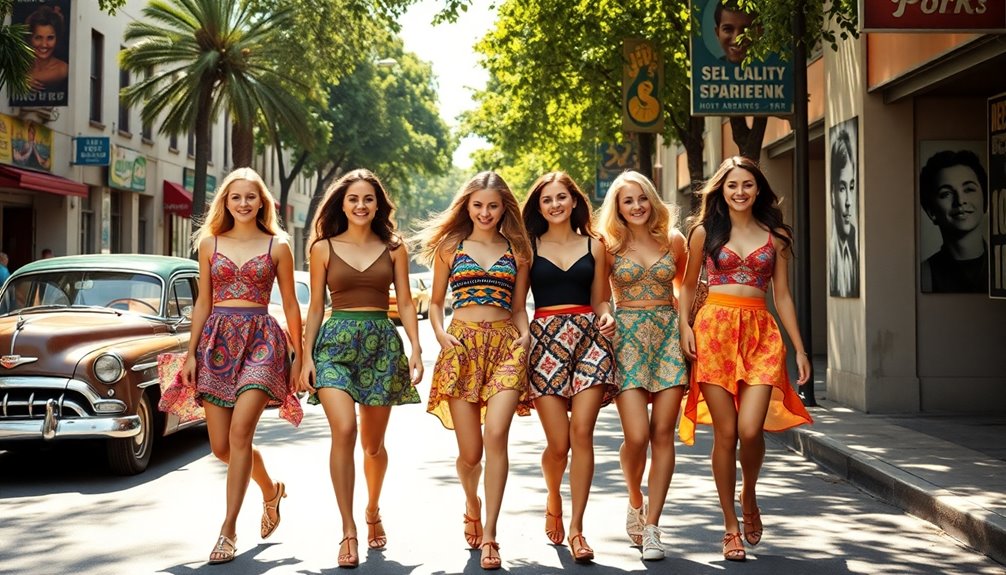
In the 1960s, miniskirts became a bold declaration of freedom and individuality, reshaping women's fashion forever. Designers like Mary Quant championed this daring style, pushing hemlines above the knee and allowing for greater movement and self-expression.
As part of the Mod fashion movement, the miniskirt embraced bold colors and geometric patterns, reflecting the vibrant youth culture of the era. Initially met with criticism, it soon gained acceptance, symbolizing a significant shift toward women's empowerment and sexual liberation.
This fashion statement not only challenged traditional norms but also mirrored the evolving dynamics of gender roles. The miniskirt revolutionized women's wardrobes, leaving a lasting impact on fashion and society that resonates to this day.
Athleisure Trend of the 2010s
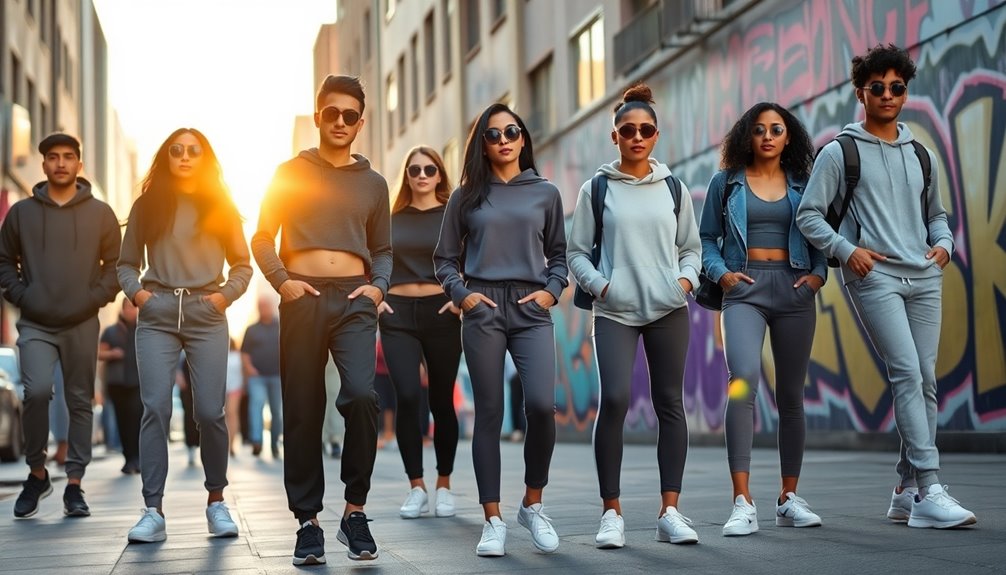
As fitness culture gained momentum in the 2010s, athleisure emerged as a transformative trend that seamlessly blended athletic wear with everyday fashion.
You found yourself gravitating toward stylish and comfortable outfits that matched your active lifestyle. Major brands like Lululemon, Nike, and Adidas led the charge, making athleisure accessible and appealing to all.
This trend featured:
- Moisture-wicking fabrics for breathability
- Stretchy materials for ease of movement
- Functional designs that prioritized comfort
- Versatile outfits that adapted effortlessly from gym to casual outings
Social media influencers showcased these looks, elevating athleisure to a must-have category in casual clothing.
With athleisure, you embraced a fashion choice that was both fashionable and practical, reflecting the spirit of the decade. Additionally, the rise of self-love practices contributed to a broader acceptance of body positivity, influencing fashion choices and styles during this era.
Frequently Asked Questions
What Is the 20 Year Rule in Fashion?
The 20 Year Rule in fashion suggests trends reappear roughly every two decades.
You'll notice how styles from the past get reinterpreted by new generations. For example, when you see chokers or high-waisted jeans making a comeback, it's likely influenced by the 1990s.
Social media plays a big role in this revival, allowing you to quickly discover and adapt these vintage trends to fit your modern tastes.
Which Decade Was the Most Fashionable?
When it comes to deciding which decade was the most fashionable, it really depends on your perspective.
If you love bold statements, the 1980s with its extravagant styles might catch your eye.
However, if you prefer the free-spirited vibe, the 1960s and its miniskirts could be your favorite.
Each decade offers unique styles that reflect cultural shifts, so you might find yourself drawn to different trends depending on your mood and personal style.
How Did Fashion Change Throughout History?
Picture a chameleon, shifting colors to blend in with its surroundings; that's how fashion has evolved over time.
It's transformed from the constrictive S-bend corsets of the early 1900s to the liberating flapper dresses of the 1920s.
You see practicality during WWII influencing modern swimwear, and then the bold miniskirts of the 1960s.
Today, you embrace sustainability and athleisure, reflecting lifestyle changes and a heightened awareness of our planet's needs.
What Were the Biggest Fashion Trends of the 20TH Century?
In the 20th century, you'd notice significant fashion trends transforming societal norms.
The flapper dress of the 1920s embodied women's liberation, while the bikini in the 1940s challenged perceptions of body image.
The 1950s introduced Dior's "New Look," emphasizing femininity.
In the 1960s, the miniskirt symbolized youthful rebellion.
By the 1980s, power suits emerged, showcasing women's empowerment in the workplace.
Each trend not only shaped style but also reflected broader cultural shifts.
Conclusion
Fashion trends shape our identities and reflect the spirit of their times. Just think about how the S-bend corset in the early 1900s emphasized an hourglass figure, while the 1960s miniskirt liberated women's fashion. As you embrace today's athleisure trend, consider how it mirrors our need for comfort and versatility. Each decade leaves its mark, reminding us that fashion isn't just about clothes; it's about the stories we tell and the lifestyles we choose.

